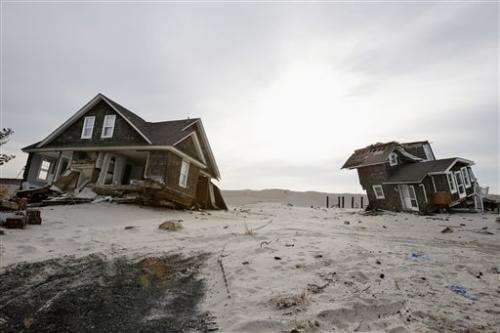This Feb. 22,2013 file photo shows Two heavily damaged homes on the beach in Mantoloking, N.J., from Superstorm Sandy. Man-made global warming may decrease the likelihood of the already unusual steering currents that pushed Superstorm Sandy due west into New Jersey in a freak 1-in-700 year path, researchers report. While that may sound like the rare good climate change news, it's probably not, according to the study's authors, because they only looked at steering currents and other factors, including stronger storms, and sea level rise can and likely will outweigh any benefit from changing air patterns. The study is disputed by other scientists who have been vocal about the meteorological factors behind Sandy. (AP Photo/Mel Evans, File)
A new study says man-made global warming may further lessen the likelihood of the freak atmospheric steering currents that last year shoved Superstorm Sandy due west into New Jersey.
But don't celebrate a rare beneficial climate change prediction just yet. The study's authors said the once-in-700-years path was only one factor in the massive $50 billion killer storm. They said other variables such as sea level rise and stronger storms will worsen with global warming and outweigh changes in steering currents predicted by computer models.
In this Nov. 9, 2012 aerial-file photo, people stand near damaged homes along the Atlantic Ocean in New Jersey after the region was pounded by Superstorm Sandy. Man-made global warming may decrease the likelihood of the already unusual steering currents that pushed Superstorm Sandy due west into New Jersey in a freak 1-in-700 year path, researchers report. While that may sound like the rare good climate change news, it's probably not, according to the study's authors, because they only looked at steering currents and other factors, including stronger storms, and sea level rise can and likely will outweigh any benefit from changing air patterns. The study is disputed by other scientists who have been vocal about the meteorological factors behind Sandy. (AP Photo/Mel Evans, File)
The study will be published Tuesday in the journal Proceedings of the National Academy of Sciences.
More information: Model projections of atmospheric steering of Sandy-like superstorms, PNAS, www.pnas.org/cgi/doi/10.1073/pnas.1308732110
Journal information: Proceedings of the National Academy of Sciences
© 2013 The Associated Press. All rights reserved.























